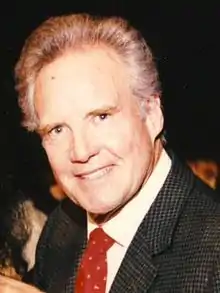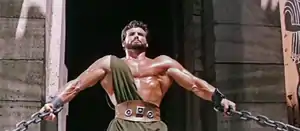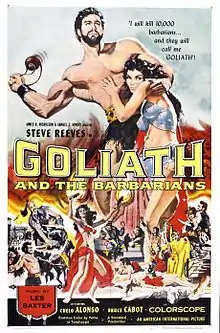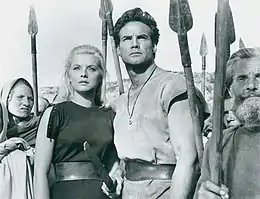Steve Reeves
Stephen Lester Reeves (January 21, 1926 – May 1, 2000) was an American professional bodybuilder, actor, and philanthropist. He was famous in the mid-1950s as a movie star in Italian-made sword and sandal films, playing the protagonist as muscular characters such as Hercules, Goliath, and Sandokan. At the peak of his career, he was the highest-paid actor in Europe.[1] Though best known for his portrayal of Hercules, he played the character only twice: in Hercules (1958), and in its 1959 sequel Hercules Unchained. By 1960, Reeves was ranked as the number-one box-office draw in 25 countries around the world.[2]
Steve Reeves | |
|---|---|
 Reeves in 1990 | |
| Born | Stephen Lester Reeves January 21, 1926 Glasgow, Montana, U.S. |
| Died | May 1, 2000 (aged 74) Escondido, California, U.S. |
| Occupation | Bodybuilder, actor, philanthropist |
| Spouse(s) | Sandra Smith
(m. 1955; div. 1956)Aline Czartjarwicz
(m. 1963; died 1989)Deborah Ann Engelhorn
(m. 1994; |
Early life
Born in Glasgow, Montana, in 1926,[1] Reeves moved to California at age 10 with his mother Goldie Reeves after his father Lester Dell Reeves died in a farming accident.[3] Reeves developed an interest in bodybuilding at Castlemont High School and trained at Ed Yarick's gym in Oakland, California.
After graduating from high school, he enlisted in the United States Army during World War II, and served in the Philippines. After his military service Reeves attended California Chiropractic College in San Francisco.[4]
He reigned as Mr. America of 1947, Mr. World of 1948, and Mr. Universe of 1950. He was contacted by an agent who suggested he go into acting.[4]
Career
Cecil B. de Mille
Reeves moved to New York where he studied acting under Stella Adler, but after arguments he was refunded his tuition. He studied instead at the Theodora Irvin School of the Theatre. He began performing a vaudeville act with a comedian named Dick Burney. One of Cecil B. De Mille's talent scouts saw him and had him tested for Samson and Delilah (1949). Reeves received a seven-year contract with Paramount.[4]
Reeves says de Mille wanted to cast him in the lead role, but told Reeves he had to lose 15 pounds in order to look convincing on-camera. Reeves says he tried to lose the weight and worked on his acting in preparation for the role over three months. Then De Mille told him he was going to give the role to Victor Mature.[4]
Early acting appearances
In 1949, he filmed a Tarzan-type television pilot called Kimbar of the Jungle, and in 1950 became Mr. Universe.
Reeves appeared on television in Stars Over Hollywood in the episode "Prison Doctor" with Raymond Burr. He appeared on the TV series Topper ("Reducing").
In 1954, Reeves had a small supporting role as a cop in the Ed Wood film Jail Bait. It was his first film and earned him his Screen Actors Guild card. "I had a suit on at all times," he later recalled. "I even had a tie. Only took my shirt off once. Those were the days, huh?"[4]
The same year Reeves was in the MGM musical Athena,[3] playing the boyfriend of Jane Powell's character.
These two films are the only ones Reeves made in the United States where his actual voice was used; Reeves acted in Italian-made films for the remainder of his career, where all dialogue and sound effects were added in post-production.
Reeves guest-starred on The George Burns and Gracie Allen Show as the owner of a gym.[5] On December 17, 1954, Reeves guest-starred in the ABC sitcom Where's Raymond?, starring Ray Bolger as Raymond Wallace, a song-and-dance man. Reeves played a well-built office employee whom Wallace sees in the company of Wallace's girlfriend, Susan.[6]
In 1955 Reeves appeared on two Broadway shows, Kismet and The Vamp.
Pictures of Reeves' costume test for the lead in Li'l Abner (1959) can be easily found on the web.
He then decided to quit acting and worked for American Health Studios in public relations, opening up fitness studios.[4]
Hercules

In Italy, director Pietro Francisci wanted to make a film about Hercules but could not find anyone suitable to play the role. His daughter recommended Reeves on the basis of his appearance in Athena and Francisci offered him the role and a plane ticket to Italy. Reeves at first did not think he was serious but eventually agreed and flew to Italy to make the film. His fee was $10,000.[4]
Hercules was a relatively low-budget epic based loosely on the tales of Jason and the Argonauts, though inserting Hercules into the lead role.[3]
The film proved popular in Europe. What made it an international sensation was when US distribution rights were bought by Joe E. Levine who spent over $1 million promoting it, turning the film into a major box-office success, grossing $5 million in the United States in 1959.[7] However this did not happen until Reeves had already made four more films in Europe.[4][8]
The first of these was a sequel to Hercules, Hercules Unchained (1959), again directed by Pietro Francisci. Reeves was paid the same fee, although his wage would double from then on. This film was another huge success, being the third most popular film in Britain in 1960.[9] Nonetheless Reeves would not play Hercules again, despite his identification with the role.[4]
Reeves' third film as star was The White Warrior (1959), based on Hadji Murat, the novel by Leo Tolstoy. He played Hadji Murad, a 19th-century Chechen chieftain who led his warriors in a fight against the invading Russians.

Reeves was then in Terror of the Barbarians playing Emilio, about the Lombard invasion of Italy. American International Pictures bought US rights and retitled it Goliath and the Barbarians (1959), with Reeves' character renamed "Goliath". The film earned $1.6 million in North America during its initial release where it was double billed with Sign of the Gladiator[10]
Injury
Reeves was Glaucus Leto in The Last Days of Pompeii (1959), based on the novel by Sir Edward Bulwer-Lytton. It co-starred Christine Kaufmann and Fernando Rey and was mostly directed by Sergio Leone.
During the filming, Reeves dislocated his shoulder when his chariot slammed into a tree;[1][3] he re-injured it while swimming in a subsequent underwater escape scene. The injury would be aggravated by his stunt work in each successive film, ultimately leading to his retirement from filmmaking.[3][11]
U.S. directors
Reeves followed this with The Giant of Marathon (1959) where he was cast as Pheidippides, the famous wartime messenger of the Battle of Marathon. By now Reeves' success was such that his films would use Hollywood directors: Marathon was directed by Mario Bava and Jacques Tourneur. According to MGM records the film earned $1,335,000 in the US and Canada and $1.4 million elsewhere resulting in a profit of $429,000.[12]
Reeves had a change of pace in Morgan, the Pirate (1960) where he played pirate and self-proclaimed governor of Jamaica, Captain Henry Morgan. Andre De Toth and Primo Zeglio directed.
He then did an "Eastern", The Thief of Baghdad (1961), playing Karim, directed by Arthur Lubin.
In The Wooden Horse of Troy (1961) Reeves played Aeneas of Troy, opposite John Drew Barrymore.
He co-starred with fellow body builder Gordon Scott in Duel of the Titans (1961), playing Romulus and Remus respectively. Sergio Corbucci directed.
Reeves played Randus, the son of Spartacus in The Slave (1962) then reprised his role as Aeneaus in War of the Trojans (1962) aka The Avenger.
Later roles

Reeves played Sandokan in two films, both directed by Umberto Lenzi: Sandokan the Great (1963) and Pirates of Malaysia (1964). Reeves said that by this stage his fee was $250,000 a film.[4]
In 1968, Reeves appeared in his final film, a spaghetti Western he co-wrote, titled I Live For Your Death! (later released as A Long Ride From Hell).[3] "I ended up with an ulcer from that," he said later. "That was my last."[13]
Reeves reportedly turned down the James Bond role in Dr. No (1962)[1] because of the low salary the producers offered.[14]
Reeves also turned down the role that finally went to Clint Eastwood in A Fistful of Dollars (1964) because he did not believe that Italians could make a western out of a Japanese samurai film.[1][11]
George Pal contacted Reeves for the role of Doc Savage in Doc Savage: The Man of Bronze, the first of what was meant to be a film series, but when filming was about to begin a Hollywood writers strike put the film on hold with Reeves and the original director replaced.[15]
His last screen appearance was in 2000 when he appeared as himself in the made-for-television A&E Biography: Arnold Schwarzenegger – Flex Appeal.
Post-acting
Reeves decided to retire for several reasons: stress, his injury, and the decline in the market for his sort of movies. He had earned enough to retire and moved to the 360-acre (150 ha) Suncrest Stock Ranch he purchased in Jacksonville just outside of Medford, Oregon – 33 miles (53 km) north of the California border.[11][16] He later purchased a ranch in Valley Center, California. It would be his home for the rest of his life.[17] Reeves bred horses and promoted drug-free bodybuilding.[1][3] The last two decades of his life were spent in Valley Center, California where he bought a ranch with savings from his film career and lived there with his second wife, Aline, until her death in 1989.[1][3][17]
Other interests
The only authorized biography, Steve Reeves – One of a Kind, was published in 1983 by Milton T. Moore. Moore worked with Reeves and Steve's wife at the time, Aline, for over 12 years before receiving publishing approval. Mr. Reeves thought so highly of Moore's work that he would sell it at his public appearances. Although it has been out of print for some time, the book has always received high accolades. See Steve Reeves International Society blog for more insight.
Against Reeves' wishes, in late 1999 Chris LeClaire published the first edition of Worlds To Conquer, The Authorized Biography Of Steve Reeves. Reeves' companion of many years, Deborah Reeves Stewart, has publicly denounced the book as not being authorized, accurate, or approved by Reeves. She joins many others who know the book was never approved. In late 2017, LeClaire published a totally revised second edition and again falsely claimed authorization, despite Mr. Reeves never reviewing the revised edition because he passed away years before (in May 2000).
In 1994, Reeves, with long-time friend and business partner George Helmer, started the Steve Reeves International Society. In 1996, it incorporated to become Steve Reeves International, Inc.
In 2003, Helmer co-authored Steve Reeves – His Legacy in Films, and in 2010, Steve Reeves' Hercules Cookbook. In 2014, he published a Reeves biography, A Moment in Time – The Steve Reeves Story. Helmer is also the executor of the Reeves' estate, exclusive owner to the rights of Reeves' name and image, and considered by many as the authority on Reeves.
Reeves wrote the book Powerwalking,[18] and two self-published books, Building the Classic Physique - The Natural Way,[19] and Dynamic Muscle Building.[20] (Note that George Helmer published a revised and updated edition of the Powerwalking book in 2013.)
Freelance writer Rod Labbe interviewed Reeves, and the article appeared in Films of the Golden Age magazine, summer 2011.[14] It was conducted in 1997 and was the last extensive interview Steve Reeves did.
Death
On May 1, 2000, Reeves died from a blood clot after having had surgery two days earlier. He died at Palomar Hospital in Escondido, California, where his second wife had also died.[3]
In popular culture
In the 1973 British musical stage production The Rocky Horror Show, and its 1975 film counterpart The Rocky Horror Picture Show, Dr. Frank N. Furter introduces himself to Brad and Janet with the song Sweet Transvestite. The lyrics include, "Or if you want something visual/That's not too abysmal/We can take in an old Steve Reeves movie."
Filmography
| Year | Title | Role | Notes |
|---|---|---|---|
| 1953 | Gentlemen Prefer Blondes | Olympic Team Member | Uncredited |
| 1954 | Jail Bait | Lieutenant Bob Lawrence | Hollywood film directed by Ed Wood Jr. |
| 1954 | Athena | Ed Perkins | Hollywood film directed by Richard Thorpe |
| 1958 | Hercules | Hercules | released in Italy in 1958, released in U.S. in 1959; a.k.a. Le fatiche di Ercole / The Labors of Hercules |
| 1959 | Hercules Unchained | Hercules | released in USA 1960; a.k.a. Ercole e la regina di Lidia / Hercules and the Queen of Lydia |
| 1959 | The White Warrior | Agi / Hadji Murad, the White Warrior | directed by Riccardo Freda; a.k.a. Hadji Murad il Diavolo Bianco / Hadji Murad, The White Devil |
| 1959 | Goliath and the Barbarians | Goliath | a.k.a. Il terrore dei barbari / Terror of the Barbarians |
| 1959 | The Last Days of Pompeii | Glaucus Leto | a.k.a. Gli ultimi giorni di Pompei / The Last Days of Pompeii |
| 1959 | The Giant of Marathon | Phillipides | a.k.a. La battaglia di Maratona / The Battle of Marathon |
| 1960 | Morgan, the Pirate | Henry Morgan | a.k.a. Morgan, il pirata/ Morgan, the Pirate |
| 1961 | The Thief of Baghdad | Karim | a.k.a. Il Ladro di Bagdad |
| 1961 | The Trojan Horse | Aeneas | a.k.a. La guerra di Troia/ The Trojan War |
| 1961 | Duel of the Titans | Romulus | a.k.a. Romolo e Remo / Romulus and Remus |
| 1962 | The Slave | Randus – son of Spartacus | a.k.a. Il Figlio di Spartaco / Son of Spartacus |
| 1962 | The Avenger | Enea / Aeneas | a.k.a. La leggenda di Enea / The Legend of Aeneas) (also released as The Last Glory of Troy); it is a sequel to The Trojan Horse |
| 1963 | The Shortest Day | Himself | a.k.a. Il giorno più corto |
| 1963 | Sandokan the Great | Sandokan | directed by Umberto Lenzi; a.k.a. Sandokan, la tigre di Mompracem/ Sandokan, the Tiger of Mompracem |
| 1964 | Pirates of Malaysia | Sandokan | directed by Umberto Lenzi; a.k.a. Sandokan, the Pirate of Malaysia / Pirates of the Seven Seas; this is a sequel to Sandokan the Great |
| 1968 | A Long Ride from Hell | Mike Sturges | spaghetti western directed by Camillo Brazzoni, produced and co-written by Steve Reeves; a.k.a. I Live for Your Death! |
References
- Lane, John Francis (June 5, 2000). "Steve Reeves: Putting muscle and myth in the movies". Retrieved July 15, 2009.
- Rutledge, Leigh W. (1989). The Gay Fireside Companion. Alyson Publications, Inc. p. 146. ISBN 978-1555831646.
- Lyman, Rick (May 5, 2000). "Steve Reeves, 74, Whose 'Hercules' Began a Genre". The New York Times. Retrieved July 15, 2009.
- Frumkes, Roy (July 1994). "An Interview with Steve Reeves". The Perfect Vision Magazine.
- "The George Burns and Gracie Allen Show". Youtube.
- "Where's Raymond?/ The Ray Bolger Show". ctva.biz. Retrieved March 14, 2011.
- IMDB: Business
- "Meet Joe Levine, Super(sales)man!: Distributor of 'Hercules' Touted as New Mike Todd". Los Angeles Times. July 27, 1959. p. C13.
- "Hercules" the favourite: AT BOX OFFICE". The Guardian. London (UK). December 8, 1960. p. 21.
- "Rental Potentials of 1960", Variety, January 4, 1961 p 47. Please note figures are rentals as opposed to total gross.
- "Interview with Steve Reeves Part two".
- The Eddie Mannix Ledger, Los Angeles: Margaret Herrick Library, Center for Motion Picture Study.
- "'Mr. Universe' is a powerwalker now". Toronto Star. January 18, 1987. p. D4.
- Labbe, Rod (November 5, 2011) Steve Reeves: Demi-God on Horseback. Films of the Golden Age
- "Cult Movies 1996: Steve Reeves – The World's Favorite Hercules". Yuchtar.com. Retrieved April 5, 2011.
- "Suncrest Stock Ranch".
- "Steve and Aline at their Valley Center Ranch in the 1980s".
- Reeves, Steve; Peterson, James (1982). Powerwalking. Bobbs-Merrill. p. 196. ISBN 978-0672527135.
- Reeves, Steve; Little, John; Tanny, Armand (December 1, 1995). Building the Classic Physique – The Natural Way. Little Wolf Press. p. 240. ISBN 978-1885096104.
- Reeves, Steve; Helmer, George (2003). Dynamic Muscle Building. John Little. p. 171. ASIN B000ME9BIQ.
Further reading
- Chapman, David. "On The Cover: Steve Reeves", Hardgainer, November 1992.
- Moore, Milton Jr. "STEVE REEVES - One of a Kind (An Authorized and Approved Reeves Biography)", 1983.
- Helmer, George. "A Moment in Time - The Steve Reeves Story", 2014
- Dowling, Dave and Helmer, George. "STEVE REEVES - His Legacy in Films", 2003
- LeClaire, Christopher. Steve Reeves Biography "WORLDS TO CONQUER – The Authorized Biography Of Steve Reeves", * , First Edition December 1999, Second Edition 2017.
External links
| Wikimedia Commons has media related to Steve Reeves. |
- Steve Reeves Biography The Authorized Biography of Steve Reeves by Chris LeClaire, Paperback 1st Edition 1999, 2nd Edition 2017
- Steve Reeves International Society
- Steve Reeves at IMDb
- Steve Reeves at the Internet Broadway Database

- How Steve Reeves Trained by John Grimek, Muscular Development November, 1964
- The Many Faces of Hercules at Brian's Drive-In Theater
- Reeves gallery and Reeves movie related articles
- Steve Reeves at Find a Grave